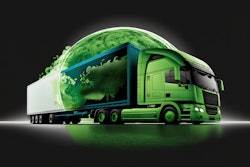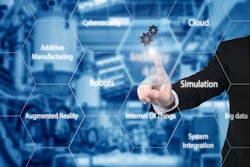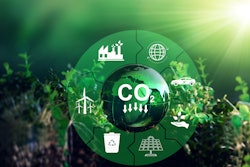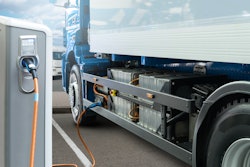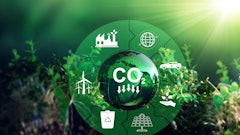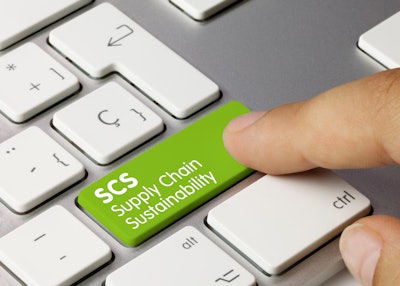
Cutting greenhouse gas emissions in half by 2030. Achieving a 100% clean electricity sector by 2035. Reaching net-zero emissions by 2050. The U.S. has set ambitious goals to reduce its carbon footprint and the impacts of climate change — but meeting these targets won’t be easy.
The transition to clean energy depends on agile, resilient and competitive supply chains that offer greater resilience, efficiency and access to renewable energy technologies, as well as the raw materials that power them. In the words of National Renewable Energy Laboratory researchers: “The nation and the world will have to speed up the manufacturing of clean energy technologies. At the same time, we need to make the entire cradle-to-grave process of producing, deploying and decommissioning those technologies equally sustainable.”
Strengthening supply chains and securing a clean energy future requires the participation and collaboration of organizations across many different industries to prioritize decarbonization — and leaders need every digital tool at their disposal to support success by making the right supply chain choices.
Increased Focus on Sustainable Supply Chains
As the U.S. and other countries work to achieve net-zero carbon emissions, demand for clean energy technologies is skyrocketing. Organizations face increased pressure to buy, transport and manufacture materials and resources more sustainably.
However, global supply chains continue to face instability and security concerns, from over-dependence on imports from a small number of countries and major corporations to recent international conflicts. In response to these challenges, the U.S. federal government has adopted a comprehensive strategy to support and strengthen America's clean energy supply chains. The approach includes building a robust energy industrial base, promoting domestic manufacturing and other efforts to secure critical supply chains for materials, components and systems used in clean power production and storage, as well as tracking carbon intensity throughout the value chain.
These initiatives parallel increased regulatory and fiscal pressure to reduce emissions and improve supply chain sustainability. For example, California passed a series of laws requiring large companies to report climate-related financial risks and disclose Scope 3 emissions. Similarly, the recently passed European Sustainability Reporting Standards increases environment reporting standards for companies doing business within the European Union. The international IFRS standards body has released two sustainability standards for auditing and financial markets purposes. Sustainability reporting for public companies will be voluntary in the US in 2024 and 2025, but mandatory thereafter. One aspect of this is carbon intensity of supply chains, transparency around scope one two and three emissions, but also sustainability-related risks, such as increased vulnerability of assets and supply chains due to climate change.
Although recent state, federal and global regulations aim to strengthen supply chains and accelerate carbon reduction initiatives, government oversight isn’t the complete picture. Companies must also prioritize advanced technologies and a “born digital” approach to enhance visibility into their own supply chains, optimize operations and reduce emissions throughout the industrial value chain.
5 Approaches to Cut Carbon Emissions in the Supply Chain
Here are areas in which digital initiatives and a “born digital” mindset can drive the adoption of cleaner supply chains.
1. Enhance feedstock decisions.
Digital solutions enable organizations to make more informed decisions about suppliers and feedstocks (the raw materials or substances used as inputs in industrial processes, such as refining and petrochemical manufacturing). In refining and petrochemical settings, for example, decision-makers have many choices in selecting feedstocks that significantly affect the overall carbon intensity of their products and operations.
With the latest generation of digital tools, operators can instead select lower carbon intensity feedstocks, such as light crudes, to create eco-friendly products they can sell at a premium. Organizations can further optimize this process with advanced planning models and AI-powered tools to optimize both carbon intensity and profitability.
2. Track energy consumption and Green Content.
Advanced planning and digital optimizer tools monitor the consumption of bio-materials and renewable energy from the start of the value chain to the end product. Accurate calculation of the renewable content created in the production process allows for improved production strategies that can help maximize the monetization of green certificates.
With these improvements in place, organizations can increase the sale of green certificates to customers willing to pay a premium, such as airlines seeking sustainable aviation fuel credits or consumer goods manufacturers aiming to increase the renewable materials used in their products, like athletic shoes. A similar digital approach applies to tracking lithium and other rare metal components in EV batteries from origin to end use to recycling and re-use.
3. Cut transportation costs.
Digitalization plays a vital role in optimizing transportation costs across the supply chain, which constitute significant Scope 3 emissions. Advanced supply chain software can build optimization models across a circuit of production plants and incorporate inbound and outbound transportation.
As a result of AI-driven logistics software, operators can more easily factor in transportation costs, means, and the resulting carbon emissions when making decisions about sourcing and supply — allowing organizations to track and minimize transportation-related Scope 3 emissions over time. For global manufacturers, the ability to efficiently plan delivery schedules and select eco-friendly transportation options is a key factor in reducing both carbon emissions and operational costs.
4. Monetize green supply chains.
Digitalization allows organizations to more effectively track and monetize green energy credits. This involves accurately calculating and optimizing renewable energy consumption and green certificates to meet customer demands.
For instance, consider a large manufacturing company that’s implemented digital supply chain tracking with blockchain technology to record the use of renewable energy in its production processes. This visibility allowed the company to accurately calculate and monetize its green credits, meeting increased demand from eco-conscious consumers while also turning its sustainability initiatives into a profitable venture.
5. Address supply chain bottlenecks.
As demand for sustainability technologies like bio-feedstock reactors, green hydrogen, and carbon capture grows, the industrial sector is projected to face supply chain challenges that could delay the deployment and execution of these crucial technologies.
Digital tools enable organizations to create supply chain optionality by identifying economic and geopolitical weak points and developing strategies to overcome them, such as diversifying their suppliers and sourcing locations to mitigate potential disruptions. Likewise, “born digital” strategies and solutions like collaboration workflows and digital twins help streamline engineering and design processes, providing a digital thread from project inception to client acceptance of an asset. These digital evolutions not only reduce bottlenecks but also empower organizations to swiftly adapt to changing market dynamics, ensuring that crucial products reach the organizations that rely on them efficiently and with greater resilience.
Building a Bridge to a More Sustainable Future
Supply chain disruptions aren’t going away. Geopolitics are not stabilizing. New challenges will inevitably arise and demand for clean suppliers and production inputs will only continue to grow. In the rapidly changing energy landscape, organizations don’t need to allow bottlenecks or barriers to hinder their efforts to cut supply chain emissions. Thankfully, with advanced digital tools, companies have the opportunity to secure operations against future supply chain disruptions, reduce emissions and stay competitive.
Digitalization is an important bridge to a cleaner and more prosperous world — and organizations that can harness emerging technologies will lead the way toward a greener, more sustainable future.




